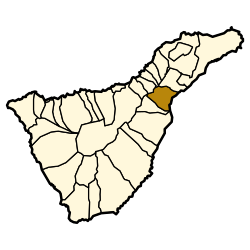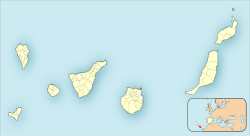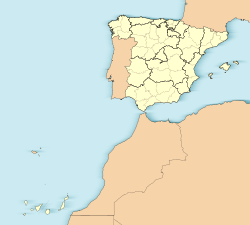Candelaria | |
|---|---|
 | |
 Municipal location in Tenerife | |
| Coordinates: 28°21′17″N 16°22′16″W / 28.35472°N 16.37111°W | |
| Country | |
| Autonomous Community | |
| Province | Santa Cruz de Tenerife |
| Island | Tenerife |
| Government | |
| • Mayor | José Gumersindo García Trujillo (PSOE) |
| Area | |
| • Total | 49.18 km2 (18.99 sq mi) |
| Population (2018)[1] | |
| • Total | 27,641 |
| • Density | 560/km2 (1,500/sq mi) |
| Time zone | UTC±0 (WET) |
| • Summer (DST) | UTC+1 (WEST) |
| Post Code | 38530 |
| Climate | BSh |
Candelaria, also Villa Mariana de Candelaria, is a municipality and city in the eastern part of the island of Tenerife in the Province of Santa Cruz de Tenerife, in the Canary Islands, Spain. The city is located on the coast, 17 km southwest of Santa Cruz de Tenerife. The population is 25,140 (2010[2]), and the area is 49.18 km².
The town is noted by Catholicsin in Spain and Latin America as a place of veneration of the Virgin of Candelaria, the patron of the Canary Islands. The most prominent building is the Basilica of Candelaria, which holds the sculpture of the Virgin Mary and murals. Also highlighted on the square are statues of the nine aboriginal kings of Tenerife.
In the times of the historic Guanche, the region was part of the menceyato, or kingdom, of Güímar. A sacred cave is situated near Candelaria that is believed to have been a place of indigenous worship for more than 3,000 years.
Since 1995 the Festival de la Canción de Candelaria has become one of the most important festivities on the island. It celebrated its 10th anniversary in 2005.
- ^ Municipal Register of Spain 2018. National Statistics Institute.
- ^ "INE". Archived from the original on 2016-09-18. Retrieved 2005-07-22.




